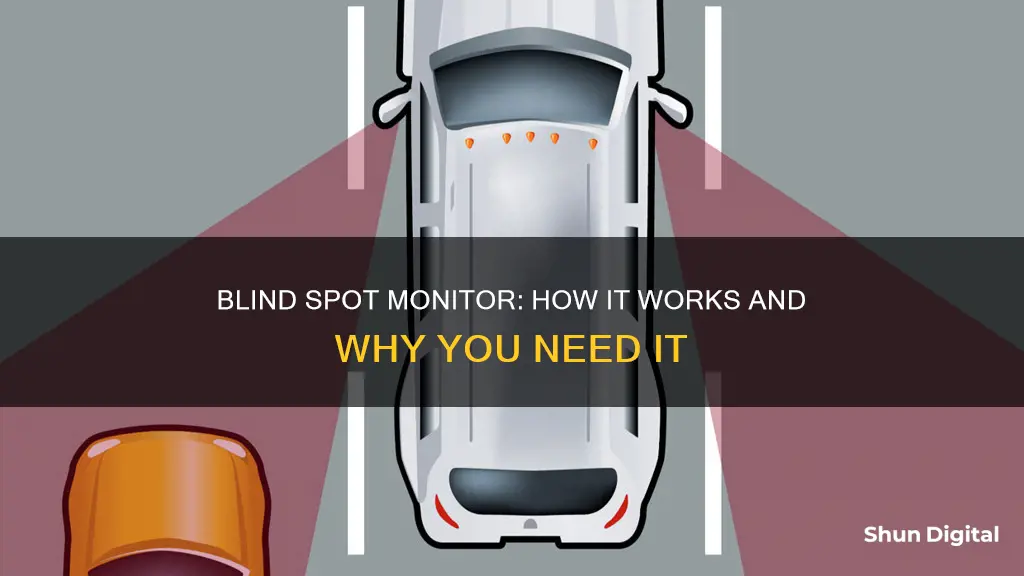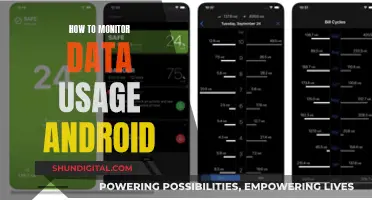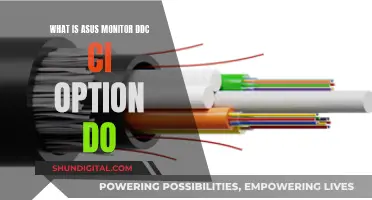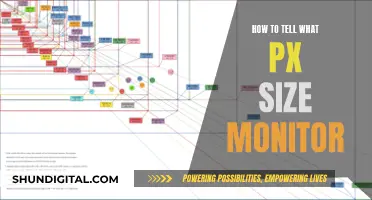
Blind-spot monitoring (BSM) is an advanced driver assistance system (ADAS) designed to increase safety by alerting the driver to vehicles that may be in their blind spot. All vehicles have blind spots – areas on either side of a car that the driver cannot see when looking into the rearview or side-view mirrors. Blind spots are why a driver should always turn their head and check for cars before changing lanes. BSM uses radar or ultrasonic sensors located inside the left and right sides of the rear bumpers, as well as cameras in the side-view mirror housings, to detect vehicles within the blind spot. When a vehicle is detected, BSM alerts the driver with a visual, audible, vibrating, or tactile warning.
| Characteristics | Values |
|---|---|
| Purpose | To detect other vehicles located to the driver's side and rear |
| Warning Types | Visual, audible, vibrating, or tactile |
| Additional Functionality | Rear Cross-Traffic Alert |
| Speed | Operational at speeds greater than 20 mph |
| Activation | Turned on or off using a control panel button or a driver interface command |
| Visual Indicator | Illuminated icon or flashing light in the side-view mirror, gauge cluster, or head-up display |
| Audible Warning | Beeping tone or repeating chime |
| Haptic Alert | Vibration through the steering wheel or seat |
| Camera Technology | Provides a video image of the side of the vehicle when the driver uses the turn signal |
| Drawbacks | May not detect motorcycles or similarly sized objects; not suitable for city streets and byways; requires regular cleaning of sensors and cameras |
What You'll Learn

How blind spot monitoring works
Blind-spot monitoring is a safety feature that watches a driver's blind spots and alerts them if they attempt to make an unsafe lane change. It is designed to increase safety by compensating for human error and reducing injuries caused by lane-change crashes.
Blind-spot monitoring uses sensors, cameras, radar, and/or ultrasonic sensors on the outside of the car to detect vehicles in the blind spot. If a vehicle is detected, the driver is alerted through visual, audible, or tactile warnings. Visual alerts include illuminated icons or flashing lights in the side-view mirror, gauge cluster, or head-up display. Audible alerts include beeping tones or repeating chimes. Tactile alerts include vibrating the steering wheel or seat.
Some systems also offer a haptic alert, such as vibration through the steering wheel or seat. More advanced systems can even intervene with subtle autonomous steering or braking to prevent collisions.
Blind-spot monitoring is not a replacement for checking mirrors and looking over one's shoulder, but it offers an added layer of safety and convenience. It is especially useful for modern vehicles, which tend to have larger side and rear blind spots.
Monitoring App Usage: Is There an App for That?
You may want to see also

Visual, audible, and tactile alerts
Blind-spot monitoring (BSM) is a vehicle-based sensor device that detects other vehicles located in the driver's side and rear blind spots. It is designed to increase safety by alerting the driver to vehicles that may have escaped visibility in the side-view mirrors. BSM uses radar or ultrasonic sensors located inside the left and right sides of the rear bumpers as well as cameras in the side-view mirror housings to detect vehicles within their monitored areas.
When a passing vehicle approaches and potentially enters a blind spot, BSM advises the driver of the vehicle's presence through visual, audible, or tactile alerts. Visual alerts typically include a flashing light or illuminated icon in the side-view mirror, gauge cluster, or head-up display. This visual alert often accompanies an audible warning such as a beeping tone or a repeating chime. Some BSM systems also offer a tactile alert such as vibration through the steering wheel or seat.
These alerts are designed to be attention-grabbing and easily noticeable by the driver. The combination of visual, audible, and tactile alerts ensures that the driver is made aware of the potential hazard, even in situations where their focus may be primarily on the road ahead. The alerts are especially useful when a driver intends to change lanes, as they provide an additional layer of safety by warning the driver of vehicles that may be in their blind spot.
While BSM systems provide valuable assistance, they are not a substitute for proper mirror adjustment, checking mirrors, and looking over one's shoulder before changing lanes. Drivers should also be aware of the limitations of BSM systems, such as their effectiveness at various speeds and their ability to detect smaller objects like motorcycles or bicycles.
Mounting Non-VESA LCD Monitors: A Simple Guide
You may want to see also

Blind spot monitoring limitations
Blind-spot monitoring (BSM) is a vehicle-based sensor device that detects other vehicles located in a car's blind spot, which is an area on either side of a car that a driver cannot see when looking into the rearview or side-view mirrors. While BSM is a useful safety feature, it does have some limitations and is not a substitute for checking mirrors and looking over one's shoulder.
One limitation of BSM is that it is primarily designed for highway use and highway speeds, and its usefulness may be limited on city streets and byways. Additionally, BSM has a maximum speed differential limit, meaning it cannot detect passing vehicles that are travelling significantly faster. This limit varies depending on the specific BSM system.
Another important consideration is that BSM relies on sensors and cameras that must be kept clean and free of obstructions. If the sensors are blocked by snow, ice, mud, dirt, or condensation, the system may not function correctly. Therefore, regular maintenance is required to ensure the system is working properly.
Furthermore, while BSM can detect most vehicles, it may not always detect smaller objects such as motorcycles or similarly sized objects on the road. It is also important to note that BSM is only an assist feature and should not be solely relied upon to determine when it is safe to change lanes. Safe driving practices, such as using turn signals, watching mirrors, and looking over shoulders, should always be followed in conjunction with BSM.
Finally, BSM systems may not issue warnings in certain situations, such as when a vehicle is approaching from the opposite direction, when a car is approaching from directly behind in the same lane, or when passing stationary objects. Therefore, drivers should remain vigilant and not solely depend on BSM to prevent all potential collisions.
Adjusting Your Monitor: Finding the Perfect Brightness
You may want to see also

Rear cross-traffic alert
The system typically uses radar or ultrasonic sensors located on each side of the vehicle near the rear bumper. These sensors monitor both sides of the vehicle for approaching traffic. However, it is important to note that rear cross-traffic alert may not detect small vehicles, such as motorcycles, or pedestrians. It also may not detect vehicles approaching from directly behind or moving away from the vehicle. Additionally, the sensors must be kept clean and free of obstructions for the system to work effectively.
Setting Up Studio Monitors and Sub: A Comprehensive Guide
You may want to see also

Blind spot monitoring history
Blind-spot monitoring (BSM), also known as blind-spot warning, blind-spot detection, or blind-spot information system, is an advanced driving assistance system (ADAS) designed to increase safety by alerting the driver to vehicles that may have escaped visibility in the side-view and rearview mirrors.
History of Blind Spot Monitoring
The concept of blind spot monitors was introduced by George Platzer in 1995. Platzer presented a paper to the Society of Automotive Engineers, suggesting that adjusting the side-view mirrors could lower the dangers of a car's blind spots. While this method was inexpensive and effective, it was challenging to find the right mirror positioning, and inexperienced drivers could put themselves in more danger by adjusting their mirrors incorrectly.
In 2001, Platzer presented the concept of a technological blind spot monitor to Ford, claiming it to be "an elegant and relatively inexpensive solution" to the problem of blind spots.
The first implementation of a blind spot detection system was by Volvo in 2001. They introduced the SCC concept car with a BLIS (Blind Spot Information System). However, the device was removed from production in 2001 and implemented in the Volvo XC90 SUV in 2003. The BLIS system used a camera to detect vehicles in the car's blind spots and alerted the driver with a visible warning. Volvo won an AutoCar Safety and Technology award for this feature.
Modern blind spot monitor systems use radar-based sensors that are more advanced and weather-resistant than cameras.
Mazda was the first Japanese automaker to offer a blind spot monitor, introducing it in the 2008 Mazda CX-9 Grand Touring. Blind spot monitoring then became a standard feature in their cars from 2009 to 2013.
Ford adopted blind spot detection systems in 2009, first introducing them in the 2010 Ford Fusion and Fusion Hybrid.
Mitsubishi is a later adopter of blind spot monitoring systems, first offering it in their Pajero Sport, launched in 2016.
Today, most modern car companies integrate blind spot monitors into their models, and it is now a commonplace option in many affordable vehicles.
Gateway Monitor Brand: How to Identify Your Model
You may want to see also
Frequently asked questions
A blind spot monitor is a vehicle-based sensor device that detects other vehicles located to the driver's side and rear. Warnings can be visual, audible, vibrating, or tactile.
Blind spot monitors use radar or ultrasonic sensors, as well as cameras, to detect vehicles in a driver's blind spot. When a vehicle is detected, the driver is alerted through a variety of methods, including visual indicators, flashing lights, beeping tones, and haptic alerts such as vibrations through the steering wheel or seat.
Blind spot monitors are useful because they increase safety by compensating for human error and alerting drivers to vehicles that may be in their blind spots. This is especially helpful for larger vehicles with bigger blind spots and can prevent lane-changing crashes and reduce injuries.







